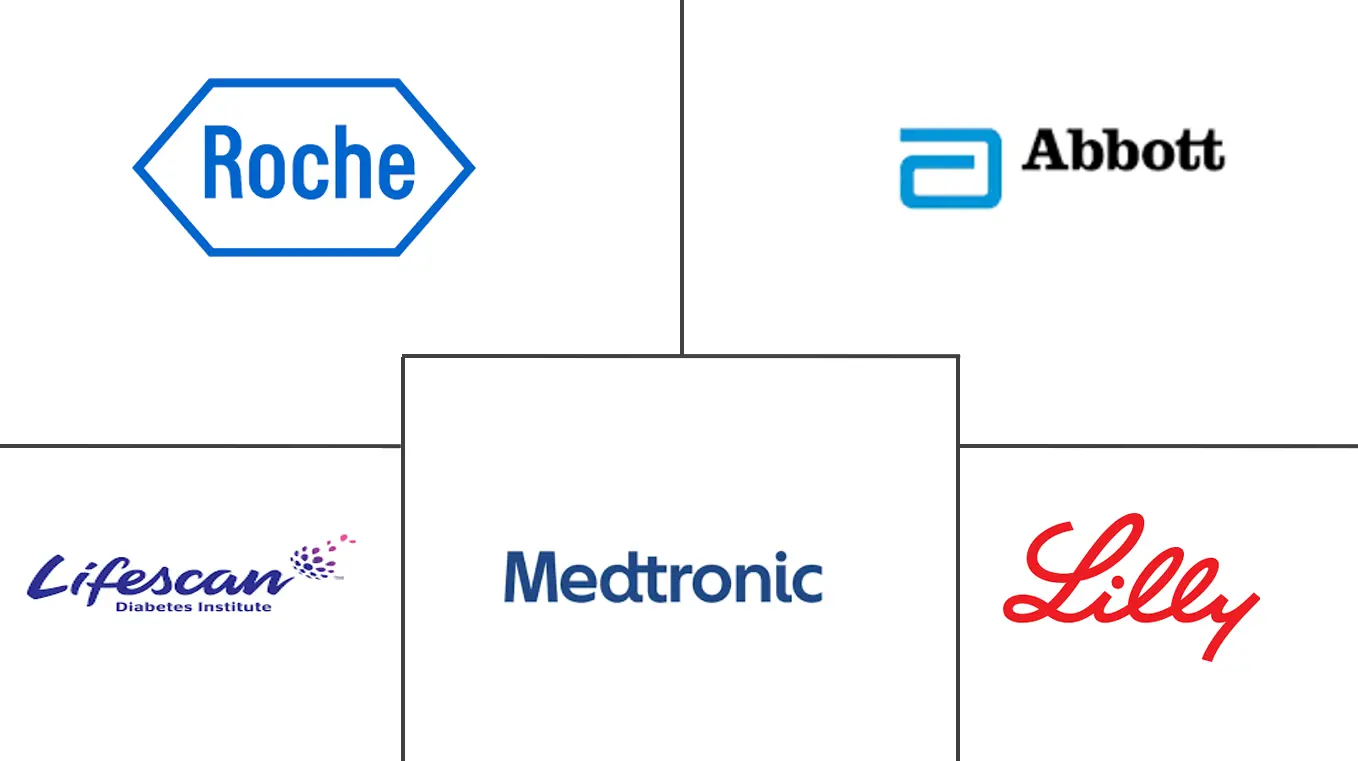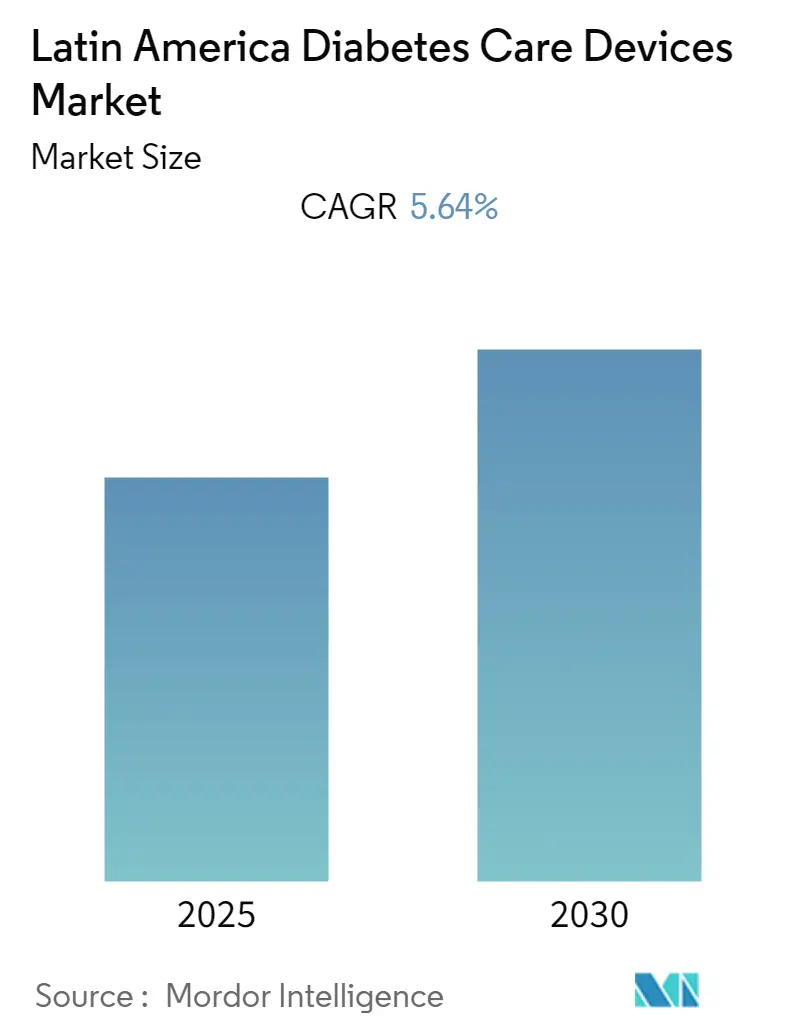
Latin America Diabetes Care Devices Market Analysis by Mordor Intelligence
The Latin America Diabetes Care Devices Market is expected to register a CAGR of 5.64% during the forecast period.
The COVID-19 pandemic has substantially impacted the Latin America Diabetes Care Devices Market. People with diabetes have a weak immune system so, with COVID-19, the immune system gets weaker very fast. People with diabetes will have more chances to get into serious complications rather than normal people. The manufacturers of diabetes care devices have taken care during COVID-19 to deliver the diabetes care devices to diabetes patients with the help of local governments. Doctors around the world suggest diabetes patients should check their diabetes levels more often to be careful and the intake of medicine has increased, which has led to an increase in the usage of diabetes care devices.
The COVID-19 pandemic has been testing the capacity to respond and adapt to populations, governments, and health systems worldwide. In the Latin America region, Brazil presented the first suspected and the first confirmed case. Most Latin American countries failed to implement timely measures to protect individuals with diabetes, which severely impacted individuals, health systems, and economies.
The diabetic prevalence is high in countries in the Latin American region, and Mexico is known to have a high number of diabetic patients due to the growing prevalence of Type-2 diabetes in the country. The gradually growing obesity rate, combined with the genetic predisposition for Type-2 diabetes, acted as a prominent driver for the increase in the Type-2 diabetic population over the last 40 years. Currently, close to 10% of the total population is living with diabetes. Diabetic patients in the Latin American region mainly suffer from Type-2 diabetes, and they accounted for close to 90% of the total diabetic population in 2021.
Therefore, owing to the aforementioned factors the studied market is anticipated to witness growth over the analysis period.
Latin America Diabetes Care Devices Market Trends and Insights
The Continuous Glucose Monitoring Segment is expected to witness the highest growth rate over the forecast period
The Continuous Glucose Monitoring Segment is expected to register the highest CAGR of about 12% over the forecast period.
To use a CGM, a small sensor is inserted into the abdomen or arm with a tiny plastic tube known as a cannula penetrating the top layer of skin. An adhesive patch holds the sensor in place, allowing it to take glucose readings day and night. Generally, the sensors are replaced every 7 to 14 days. A small, reusable transmitter connected to the sensor allows the system to send real-time readings wirelessly to a monitor device that displays blood glucose data. Some systems have a dedicated monitor, and some display the information via a smartphone app.
Continuous glucose monitoring sensors use glucose oxidase to detect blood sugar levels. Glucose oxidase converts glucose to hydrogen peroxidase, which reacts with the platinum inside the sensor, producing an electrical signal to be communicated to the transmitter. Sensors are the most important part of continuous glucose monitoring devices. Technological advancements to improve the accuracy of the sensors are expected to drive segment growth during the forecast period.
The frequency of monitoring glucose levels depends on the type of diabetes, which varies from patient to patient. Type-1 diabetic patients must check their blood glucose levels regularly, monitor their blood glucose levels, and adjust the insulin dosing accordingly. The CGM devices show a detailed representation of blood glucose patterns and tendencies compared to a routine check of glucose levels at set intervals. Furthermore, the current continuous glucose monitoring devices can either retrospectively display the trends in blood glucose levels by downloading the data or give a real-time picture of glucose levels through receiver displays.
Most private health insurance plans in Latin America cover medical assistance, procedures, and hospitalization. The region is undergoing a remarkable epidemiological transformation. Diabetes and other chronic, nontransmissible diseases are the leading health problems. Although only 10% of the diabetes population is type-1, the demand for CGM is driven by increased awareness about the benefits of blood glucose monitoring for diabetes patients. Other factors, such as innovative product development by major companies and the rise in the geriatric and obese population, may fuel the market's growth.
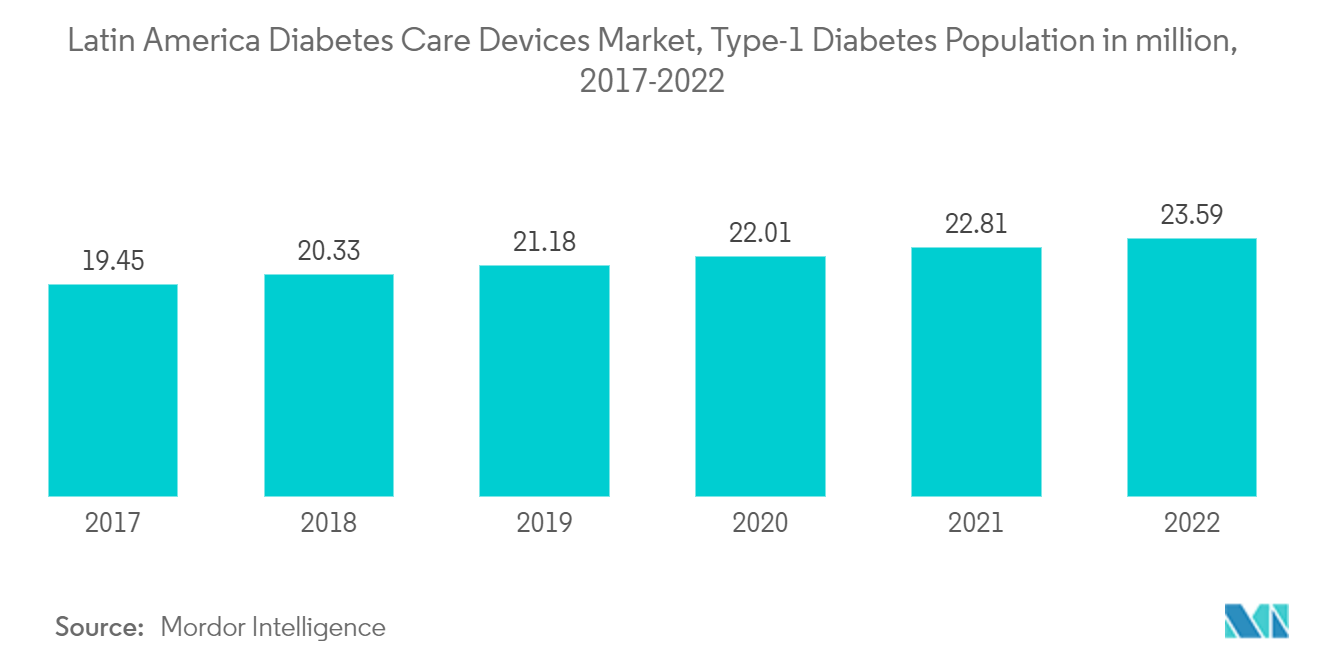
Brazil holds the highest market share in the Latin America Diabetes Care Devices Market in the current year
Brazil holds the highest market share in the Latin America Diabetes Care Devices Market this year and is expected to grow at a CAGR of about 5.6% over the forecast period.
According to IDF Diabetes Atlas 2021, among 15.7 million adults, about 10.5% had diabetes in Brazil. The cost of diabetes-related health expenditure in Brazil is the third highest in the world. In addition, 18 million adults have Impaired Glucose Tolerance which places them at high risk of developing type 2 diabetes. Additional data on glycemic control in Brazil show that only 25% met the therapeutic goal of glycated hemoglobin (HbA1c) less than 7% before the pandemic, as recommended by the Brazilian Diabetes Society.
Brazil has implemented a set of reforms to improve the distribution of doctors, develop new forms of the service organization, introduce new financing models, and implement a range of quality improvement initiatives and policy frameworks to overcome risk factors such as obesity. This also highlights opportunities for continuing and expanding innovations in the delivery of diabetes care and the use of diabetes technology. In Brazil, the Brazilian health system is managed by each state and local health secretariat and is governed by the MOH. Furthermore, in many towns where the public sector cannot meet people's requirements, partnerships with private organizations to increase access to public healthcare have been put in place.
According to Universal Health Coverage 2022, four nations, including Argentina, Brazil, Colombia, and Mexico, achieved an overall index of essential coverage of 76-77 percent, with households spending less than 25 percent of their income on health care and expanding access to primary healthcare systems and coverage for noncommunicable illnesses enhanced service coverage, while a rise in the number of qualified healthcare personnel enabled community outreach. In Brazil, the public health system (Sistema Único de Saúde; SUS) has progressively increased the assistance available for individuals with diabetes. The Ministry of Health established a list of medications and supplies the Brazilian Health System (SUS) provided to patients who have diabetes.
Such factors are expected to drive market growth over the forecast period.
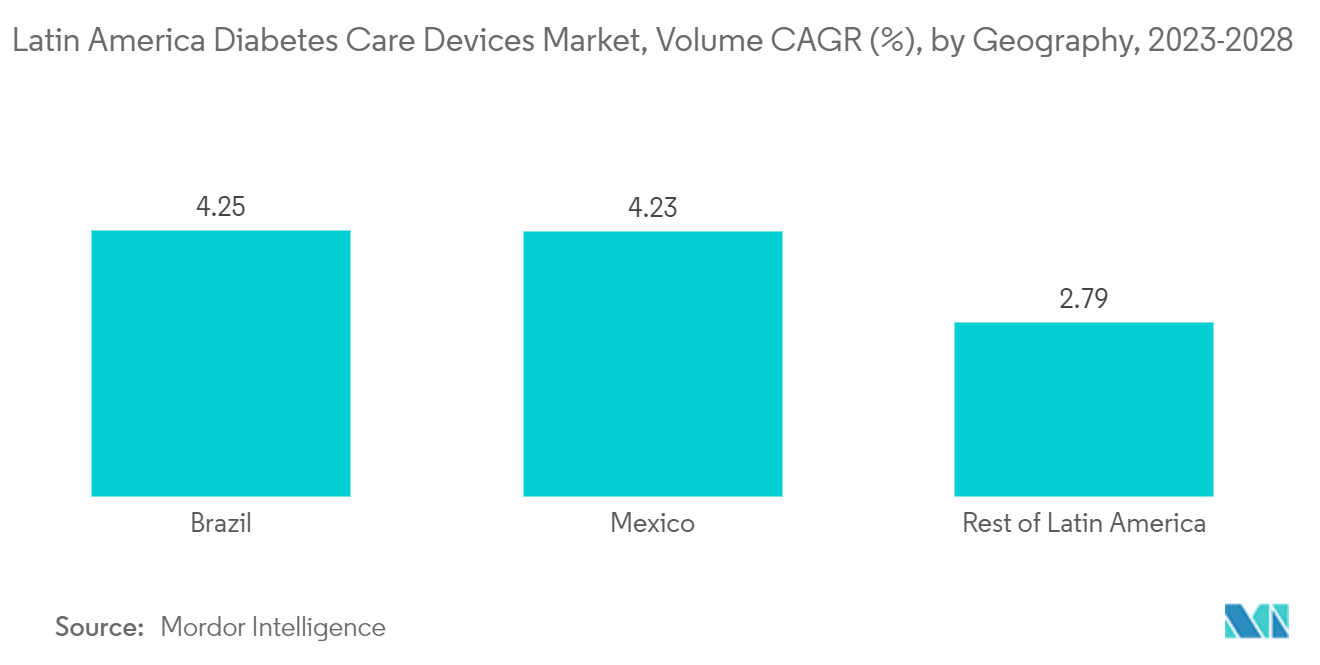
Competitive Landscape
The Latin America Diabetes Care Devices Market is moderately fragmented. The major players, such as Abbott, Roche, Medtronic, etc., resort to inorganic market strategies, such as mergers and acquisitions, to establish market dominance while also adhering to organic growth strategies, which is evident from the R&D spending of these companies.
Latin America Diabetes Care Devices Industry Leaders
Abbott Diabetes Care
Medtronic PLC
Lifescan Inc.
Roche Diabetes Care
Eli Lilly and Company
- *Disclaimer: Major Players sorted in no particular order
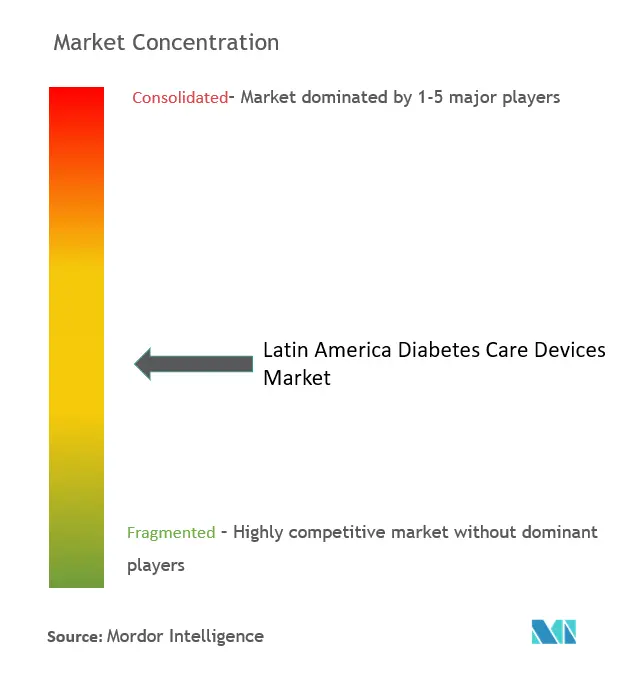
Recent Industry Developments
- January 2023: LifeScan announced that the peer-reviewed Journal of Diabetes Science and Technology published Improved Glycemic Control Using a Bluetooth Connected Blood Glucose Meter and a Mobile Diabetes App: Real-World Evidence From Over 144,000 People With Diabetes, detailing results from a retrospective analysis of real-world data from over 144,000 people with diabetes - one of the largest combined blood glucose meter and mobile diabetes app datasets ever published.
- October 2022: Becton, Dickinson, and Company and Biocorp announced that they had signed an agreement to use connected technology to track adherence to self-administered drug therapies, like biologics. To support biopharmaceutical companies in their efforts to improve the adherence and outcomes of injectable drugs, the two companies will integrate Biocorp's Injay technology-a solution designed to capture and transmit injection events using Near Field Communication technology to the BD UltraSafe Plus Passive Needle Guard used with pre-fillable syringes.
Latin America Diabetes Care Devices Market Report Scope
Diabetes care devices are the hardware, equipment, and software used by diabetes patients to regulate blood glucose levels, prevent diabetes complications, lessen the burden of diabetes, and enhance the quality of life. The Latin America Diabetes Care Devices Market is segmented into Monitoring Devices (Self-monitoring Blood Glucose Device, Continuous Glucose Monitoring Device), Management Devices (Insulin Pump, Insulin Syringes, Cartridges in Reusable pens, Disposable Pens, and Jet Injectors), and Geography (Brazil, Mexico, and Rest of Latin America). The report offers the value (in USD) and volume (in Units) for the above segments. Further, the report will cover a segment-wise breakdown (Value and Volume) for all the countries covered under the Table of Contents.
| Self-monitoring Blood Glucose Device | Glucometer Devices |
| Blood Glucose Test Strips | |
| Lancets | |
| Continuous Glucose Monitoring Device | Sensors |
| Durables (Receivers and Transmitters) |
| Insulin Pump | Insulin Pump Device |
| Insulin Pump Reservoir | |
| Infusion Set | |
| Insulin Syringes | |
| Cartridges in Reusable pens | |
| Disposable Pens | |
| Jet Injectors |
| Brazil |
| Mexico |
| Rest of Latin America |
| Monitoring Devices | Self-monitoring Blood Glucose Device | Glucometer Devices |
| Blood Glucose Test Strips | ||
| Lancets | ||
| Continuous Glucose Monitoring Device | Sensors | |
| Durables (Receivers and Transmitters) | ||
| Management Devices | Insulin Pump | Insulin Pump Device |
| Insulin Pump Reservoir | ||
| Infusion Set | ||
| Insulin Syringes | ||
| Cartridges in Reusable pens | ||
| Disposable Pens | ||
| Jet Injectors | ||
| Geography | Brazil | |
| Mexico | ||
| Rest of Latin America | ||
Key Questions Answered in the Report
What is the current Latin America Diabetes Care Devices Market size?
The Latin America Diabetes Care Devices Market is projected to register a CAGR of 5.64% during the forecast period (2025-2030)
Who are the key players in Latin America Diabetes Care Devices Market?
Abbott Diabetes Care, Medtronic PLC, Lifescan Inc., Roche Diabetes Care and Eli Lilly and Company are the major companies operating in the Latin America Diabetes Care Devices Market.
What years does this Latin America Diabetes Care Devices Market cover?
The report covers the Latin America Diabetes Care Devices Market historical market size for years: 2019, 2020, 2021, 2022, 2023 and 2024. The report also forecasts the Latin America Diabetes Care Devices Market size for years: 2025, 2026, 2027, 2028, 2029 and 2030.
Page last updated on:
Latin America Diabetes Care Devices Market Report
Statistics for the 2025 Latin America Diabetes Care Devices market share, size and revenue growth rate, created by Mordor Intelligence™ Industry Reports. Latin America Diabetes Care Devices analysis includes a market forecast outlook for 2025 to 2030 and historical overview. Get a sample of this industry analysis as a free report PDF download.
